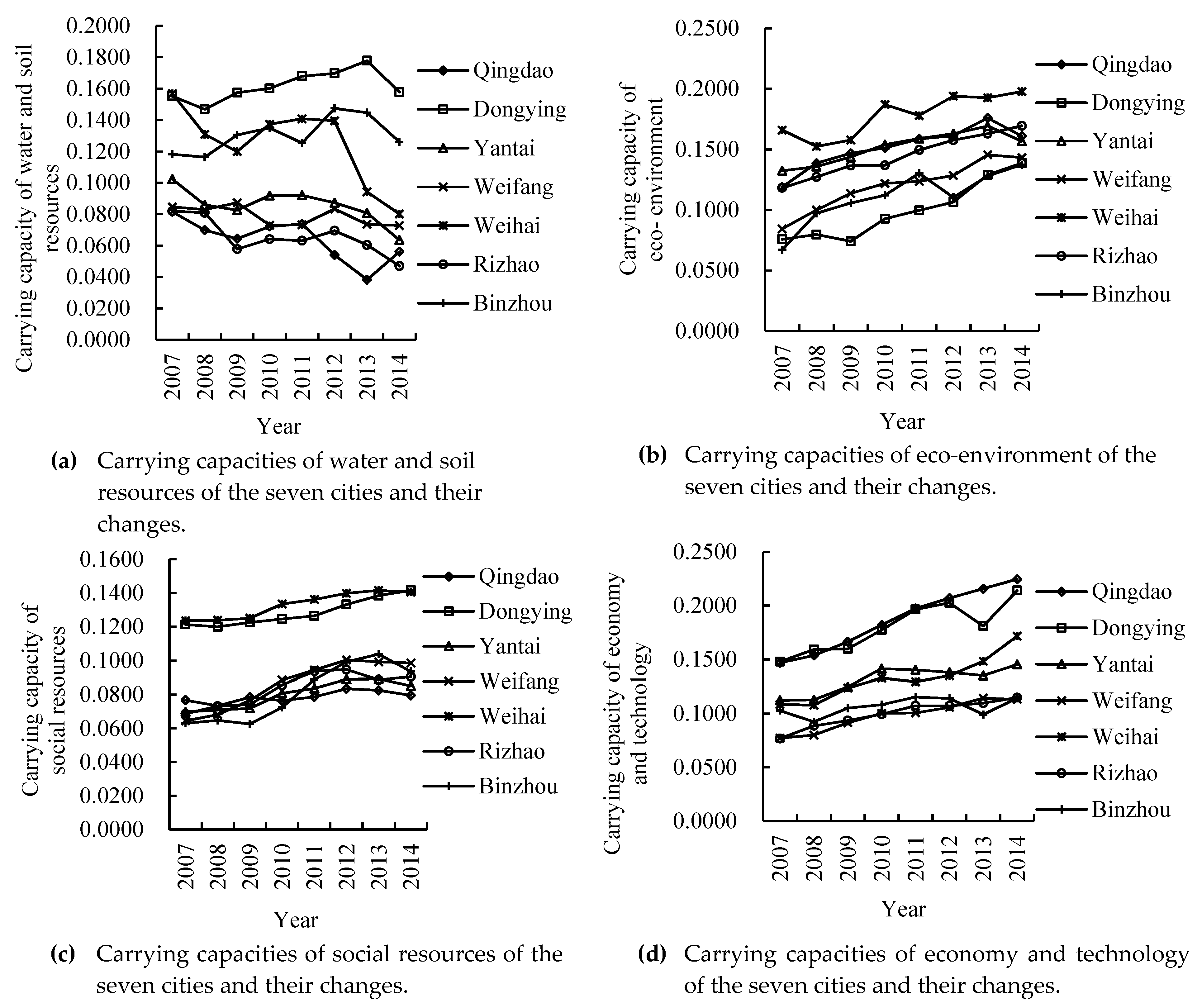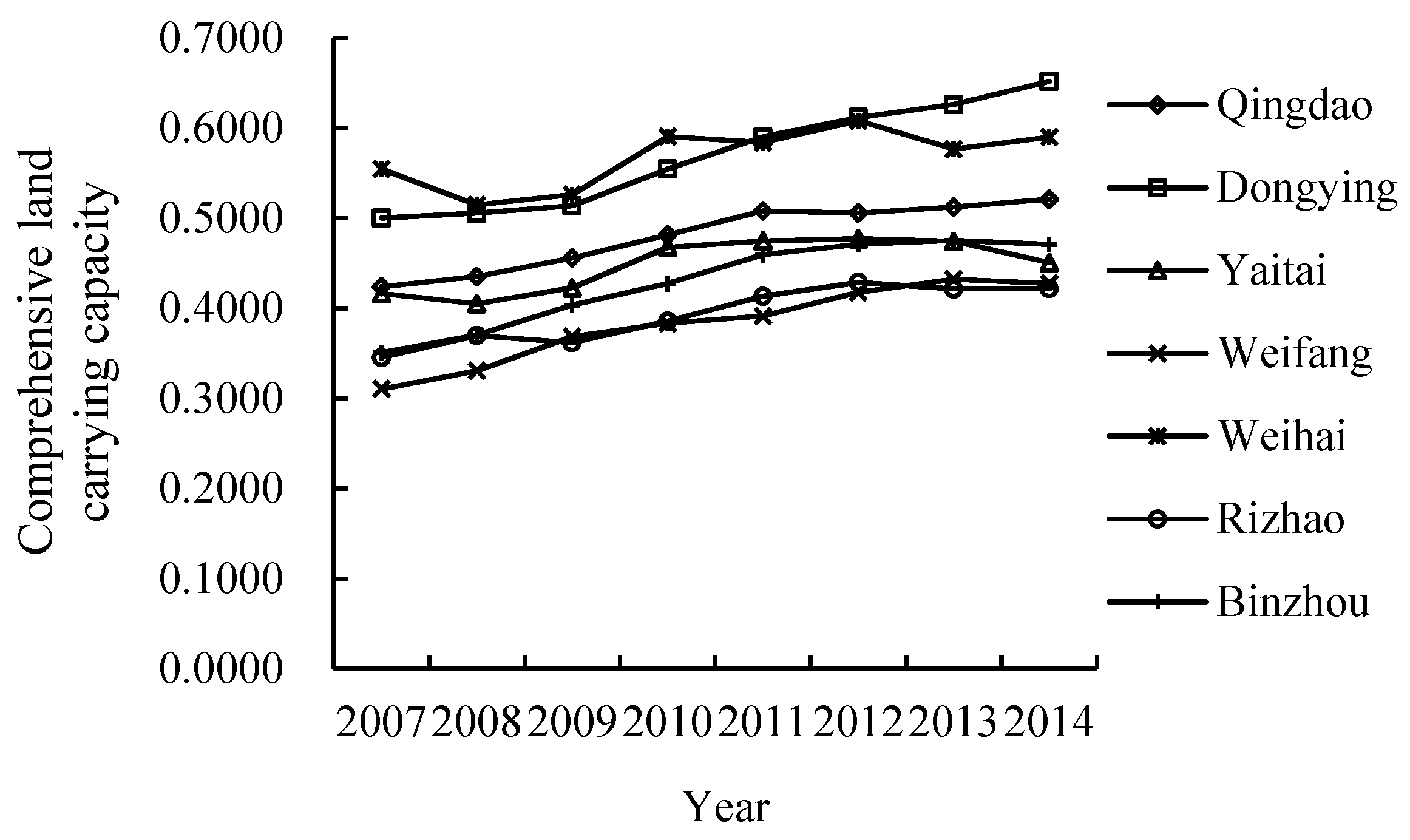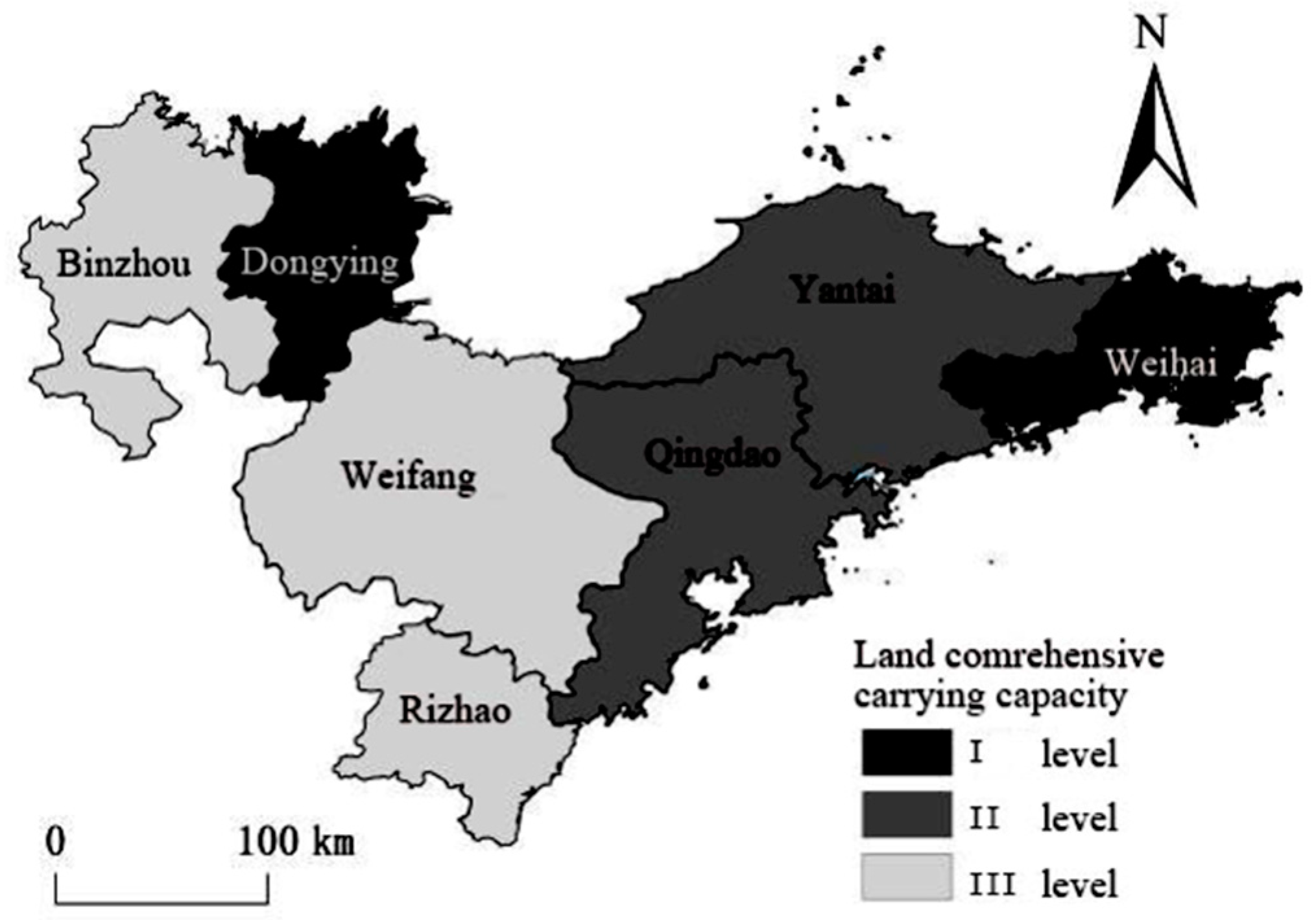Comprehensive Land Carrying Capacities of the Cities in the Shandong Peninsula Blue Economic Zone and their Spatio-Temporal Variations
Abstract
:1. Introduction
2. Research methods
2.1. Research Area
2.2. Establish Evaluation Index System
2.3. Data Source and Processing Method
2.4. Determining the Weight of the Indicators
2.5. Calculation of the Indicators of Comprehensive Land Carrying Capacity
3. Results of Evaluation and Analysis
3.1. Annual Changes and Spatial Differences of the Supporting Land Carrying Capacity Subsystems
3.2. Annual Changes of the Comprehensive Land Carrying Capacity
3.3. Spatial Differences of the Comprehensive Land Carrying Capacity of the Seven Cities
4. Conclusions and Discussion
4.1. Conclusions
4.2. Discussions
Author Contributions
Funding
Acknowledgments
Conflicts of Interest
References
- Guo, S.; Li, C.; Liu, S.; Zhou, K. Land carrying capacity in rural settlements of three gorges reservoir based on the system dynamic model. Nat. Resour. Model. 2018, 31, e12152. [Google Scholar] [CrossRef]
- Millington, R.; Gifford, R. Energy and How We Live; Australian UNESCO Seminar, Committee for Man and Biospher: Adelaide, Australia, 1973. [Google Scholar]
- Jin, X.M.; Chen, L. Paradigm shift in the study of land carrying capacity: An overview. J. Nat. Resour. 2018, 33, 526–540. [Google Scholar]
- Higgins, G.M.; Kassan, A.H.; Naiken, L.; Shah, M.M. Potential Population Supporting Capacities of Lands in the Developing World; Food & Agriculture Organization: Washington, DC, USA, 1982. [Google Scholar]
- Slessor, M. Enhancement of Carrying Capacity Options ECCO; The Resource Use Institute: London, UK, 1990. [Google Scholar]
- Chen, B.M. An outline of the research method of the project “the productivity and population carrying capacity of the land resource in China”. J. Nat. Res. 1991, 6, 197–205. [Google Scholar]
- Wang, S.H.; Mao, H.Y. Design and evaluation on the indicator system of land comprehensive carrying capacity. J. Nat. Resour. 2001, 16, 248–254. [Google Scholar]
- Wang, S.H.; Mao, H.Y.; Zhao, M.H. Thinking on the index system design to the land comprehensive carrying capacity—A case study: Coastal region of China. Hum. Geogr. 2001, 16, 57–61. [Google Scholar]
- Zhang, B.; Xue, J.B.; Fan, Q.; Jia, K.J. An evaluation of regional land comprehensive carrying capacity and spatial disparity analysis—A case of Jiaxing City. In Proceedings of the Zhejiang Province. International Symposium on Humanistic Management and Development of New Cities and Towns, Hangzhou, China, 31 October–2 November 2014; pp. 174–180. [Google Scholar]
- Yu, G.H.; Sun, C.Z. Land carrying capacity spatiotemporal differentiation in the Bohai Sea coastal areas. Acta Ecol. Sin. 2015, 35, 4860–4870. [Google Scholar]
- Jiang, Q.X.; Fu, Q.; Meng, J.; Wang, Z.L.; Zhao, K. Comprehensive evaluation of land resources carrying capacity under different scales based on RAGA-PPC. In Computer and Computing Technologies in Agriculture VIII (CCTA 2014), Beijing, China, 16–19 September 2014; Li, D., Chen, Y., Eds.; IFIP Advances in Information and Communication Technology; Springer International Publishing: Cham, Switzerland, 2015; Volume 452, pp. 200–209. [Google Scholar]
- Guo, H.H.; Li, B.; Hou, Y. Research on the capacity of land resource based on land function: Haidian as an example. J. Beijing Normal Univ. (Nat. Sci.) 2011, 47, 424–427. [Google Scholar]
- Cheng, K.; Fu, Q.; Cui, S.; Li, T.X.; Pei, W.; Liu, D.; Meng, J. Evaluation of the land carrying capacity of major grain-producing areas and the identification of risk factors. Nat. Hazards 2017, 86, 263–280. [Google Scholar] [CrossRef]
- Shi, Y.S.; Wang, H.F.; Yin, C.Y. Evaluation method of urban land population carrying capacity based on GIS: A case of Shanghai, China. Comput. Environ. Urban Syst. 2013, 39, 27–38. [Google Scholar] [CrossRef]
- He, R.W.; Liu, S.Q.; Liu, Y.W. Application of SD model in analyzing the cultivated land carrying capacity: A case study in Bijie Prefecture, Guizhou Province, China. Procedia Environ. Sci. 2011, 1985–1991. [Google Scholar] [CrossRef]
- Zhang, Y.Z.; Chang, L.P.; Zhang, B.; Zhang, S.W.; Huang, T.Q.; Liu, Y.Q. Land resources survey by remote sensing and analysis of land carrying capacity for population in Tumen river region. Chin. Geogr. Sci. 1996, 6, 342–350. [Google Scholar] [CrossRef]
- Thapa, G.B.; Paudel, G.S. Evaluation of the livestock carrying capacity of land resources in the Hills of Nepal based on total digestive nutrient analysis. Agric. Ecosyst. Environ. 2000, 78, 223–235. [Google Scholar] [CrossRef]
- Yang, Z.Y.; Song, J.X.; Cheng, D.D.; Xia, J.; Li, Q.; Ahamad, M.I. Comprehensive evaluation and scenario simulation for the water resources carrying capacity in Xi’an city, China. J. Environ. Manag. 2019, 230, 221–233. [Google Scholar] [CrossRef] [PubMed]
- Peng, B.H.; Wang, Y.Y.; Elahi, E.; Wei, G. Evaluation and prediction of the ecological footprint and ecological carrying capacity for Yangtze River urban agglomeration based on the Grey Model. Int. J. Environ. Res. Public Health 2018, 15, 2543. [Google Scholar] [CrossRef] [PubMed]
- National Development and Reform Commission. Shandong Peninsula Blue Economic Zone Development Plan; National Development and Reform Commission: Beijing, China, 2012. [Google Scholar]
- Yu, S.; Wang, M.Y. Comprehensive evaluation of scenario schemes for multi-objective decision-making in river ecological restoration by artificially recharging river. Water Resour. Manag. 2014, 28, 5555–5571. [Google Scholar] [CrossRef]
- Sun, Y.; Li, X.G. The research on the coordinated development degree of urban land comprehensive carrying capacity system in Shandong province. China Popul. Resour. Environ. 2013, 23, 123–129. [Google Scholar]
- Zhang, X.L.; Zhang, Z.H.; Su, W.X. Comprehensive assessment of the ecological carrying capacity of the Yellow River delta. J. Saf. Environ. 2015, 15, 364–369. [Google Scholar] [CrossRef]
- Liu, Y.; Zeng, C.; Cui, H.; Song, Y. Sustainable land urbanization and ecological carrying capacity: A spatially explicit perspective. Sustainability 2018, 10, 3070. [Google Scholar] [CrossRef]
- Zhou, S.H.; Chen, G.Q.; Fang, L.G.; Nie, Y.W. GIS-based integration of subjective and objective weighting methods for regional landslides susceptibility mapping. Sustainability 2016, 8, 334. [Google Scholar] [CrossRef]
- Herva, M.; Roca, E. Review of combined approaches and multi-criteria analysis for corporate environmental evaluation. J. Clean. Prod. 2013, 39, 355–371. [Google Scholar] [CrossRef]
- Lu, B.H. Study on Comprehensive Carrying Capacity of Land Resources in Linan Based on Multi-Index System; Zhejiang University: Hangzhou, China, 2014. [Google Scholar]
- Xue, R.; Wang, C.; Liu, M.L.; Zhang, D.; Li, K.L.; Li, N. A new method for soil health assessment based on analytic hierarchy process and meta-analysis. Sci. Total Environ. 2019, 650, 2771–2777. [Google Scholar] [CrossRef] [PubMed]
- Zhang, Y.R.; Ma, J.Z.; Qi, Z. Human activities, climate change and water resources in Shiyang Basin. Resour. Sci. 2012, 34, 1922–1928. [Google Scholar]
- Koens, K.; Postma, A.; Papp, B. Is overtourism overused? Understanding the impact of tourism in a city context. Sustainability 2018, 10, 4384. [Google Scholar] [CrossRef]



| Target Layer | Criterion Layer | Index Layer | Subjective Weight Calculated by Analytic Hierarchy Process | Objective Weight Calculated by Standard Deviation Method | The Weight Calculated by Multi-Criterion Comprehensive Method |
|---|---|---|---|---|---|
| Comprehensive land carrying capacities of cities in Shandong Peninsula Blue Economic Zone | Carrying capacity of water and soil resources/C1 | Cultivated land per capita C11/(hm2/capita) | 0.0770 | 0.0376 | 0.0570 |
| Effective irrigation rate of cultivated land C12/(%) | 0.0376 | 0.0354 | 0.0365 | ||
| Water resource per capita C13/(m3/capita) | 0.0199 | 0.0367 | 0.0284 | ||
| Intensity of land exploitation C14/(%) | 0.0247 | 0.0357 | 0.0303 | ||
| Land for construction per capita C15/(m2/capita) | 0.0550 | 0.0367 | 0.0457 | ||
| Proportion of wetlands to total land area C16/(%) | 0.0177 | 0.0348 | 0.0264 | ||
| Coordination of water and land C17/(%) | 0.0422 | 0.0375 | 0.0398 | ||
| Carrying capacity of eco-environment/C2 | Percentage of green space to built up area C21/(%) | 0.0365 | 0.0339 | 0.0352 | |
| Public green space per capita C22/(m2/capita) | 0.0252 | 0.0357 | 0.0305 | ||
| Forest coverage rate C23/(%) | 0.0712 | 0.0357 | 0.0532 | ||
| Proportion of environment protection investment to GDP C24/(%) | 0.0116 | 0.0406 | 0.0263 | ||
| Comprehensive utilization rate of industrial solid waste residues C25/(%) | 0.0134 | 0.0411 | 0.0275 | ||
| Urban sewage treatment rate C26/(%) | 0.0180 | 0.0353 | 0.0268 | ||
| Discharge of industrial wastewater per 10,000 Yuan RMB GDP C27/(t) | 0.0180 | 0.0414 | 0.0299 | ||
| Carrying capacity of social resources/C3 | Population density C31/(capita/m2) | 0.0537 | 0.0312 | 0.0423 | |
| Natural population growth rate C32/(%) | 0.0105 | 0.0394 | 0.0252 | ||
| Registered urban unemployment rate C33/(%) | 0.0195 | 0.0395 | 0.0297 | ||
| Urbanization rate C34/(%) | 0.0314 | 0.0402 | 0.0359 | ||
| Proportion of technology and education investment to total GDP C35/(%) | 0.0105 | 0.0315 | 0.0212 | ||
| Urban road area per capita C36/(m2) | 0.0074 | 0.0390 | 0.0235 | ||
| Carrying capacity of economy and technology/C4 | GDP per capita C41/(×104 Yuan RMB) | 0.1142 | 0.0359 | 0.0744 | |
| Economy density C42/(×104 Yuan RMB/m2) | 0.0792 | 0.0348 | 0.0566 | ||
| Growth rate of GDP C43/(%) | 0.0615 | 0.0415 | 0.0513 | ||
| Fixed assets investment per area C44/(×104Yuan RMB/hm2) | 0.0549 | 0.0397 | 0.0472 | ||
| Yield of grain per area C45/(kg/hm2) | 0.0398 | 0.0374 | 0.0386 | ||
| Proportion of value added of the primary industry to total GDP C46/(%) | 0.0211 | 0.0414 | 0.0314 | ||
| Proportion of value added of the secondary industry to total GDP C47/(%) | 0.0284 | 0.0305 | 0.0295 |
| City | 2007 | 2008 | 2009 | 2010 | 2011 | 2012 | 2013 | 2014 |
|---|---|---|---|---|---|---|---|---|
| Qingdao | 0.424 | 0.435 | 0.456 | 0.482 | 0.508 | 0.506 | 0.513 | 0.521 |
| Dongying | 0.500 | 0.506 | 0.514 | 0.555 | 0.590 | 0.612 | 0.626 | 0.652 |
| Yantai | 0.417 | 0.405 | 0.423 | 0.468 | 0.475 | 0.477 | 0.474 | 0.451 |
| Weifang | 0.311 | 0.331 | 0.369 | 0.384 | 0.392 | 0.418 | 0.433 | 0.428 |
| Weihai | 0.555 | 0.515 | 0.526 | 0.591 | 0.584 | 0.608 | 0.577 | 0.590 |
| Rizhao | 0.345 | 0.370 | 0.362 | 0.386 | 0.414 | 0.429 | 0.422 | 0.422 |
| Binzhou | 0.351 | 0.371 | 0.404 | 0.428 | 0.460 | 0.471 | 0.476 | 0.471 |
© 2019 by the authors. Licensee MDPI, Basel, Switzerland. This article is an open access article distributed under the terms and conditions of the Creative Commons Attribution (CC BY) license (http://creativecommons.org/licenses/by/4.0/).
Share and Cite
Cui, G.; Zhang, X.; Zhang, Z.; Cao, Y.; Liu, X. Comprehensive Land Carrying Capacities of the Cities in the Shandong Peninsula Blue Economic Zone and their Spatio-Temporal Variations. Sustainability 2019, 11, 439. https://doi.org/10.3390/su11020439
Cui G, Zhang X, Zhang Z, Cao Y, Liu X. Comprehensive Land Carrying Capacities of the Cities in the Shandong Peninsula Blue Economic Zone and their Spatio-Temporal Variations. Sustainability. 2019; 11(2):439. https://doi.org/10.3390/su11020439
Chicago/Turabian StyleCui, Guangming, Xuliang Zhang, Zhaohui Zhang, Yinghui Cao, and Xiujun Liu. 2019. "Comprehensive Land Carrying Capacities of the Cities in the Shandong Peninsula Blue Economic Zone and their Spatio-Temporal Variations" Sustainability 11, no. 2: 439. https://doi.org/10.3390/su11020439
APA StyleCui, G., Zhang, X., Zhang, Z., Cao, Y., & Liu, X. (2019). Comprehensive Land Carrying Capacities of the Cities in the Shandong Peninsula Blue Economic Zone and their Spatio-Temporal Variations. Sustainability, 11(2), 439. https://doi.org/10.3390/su11020439




